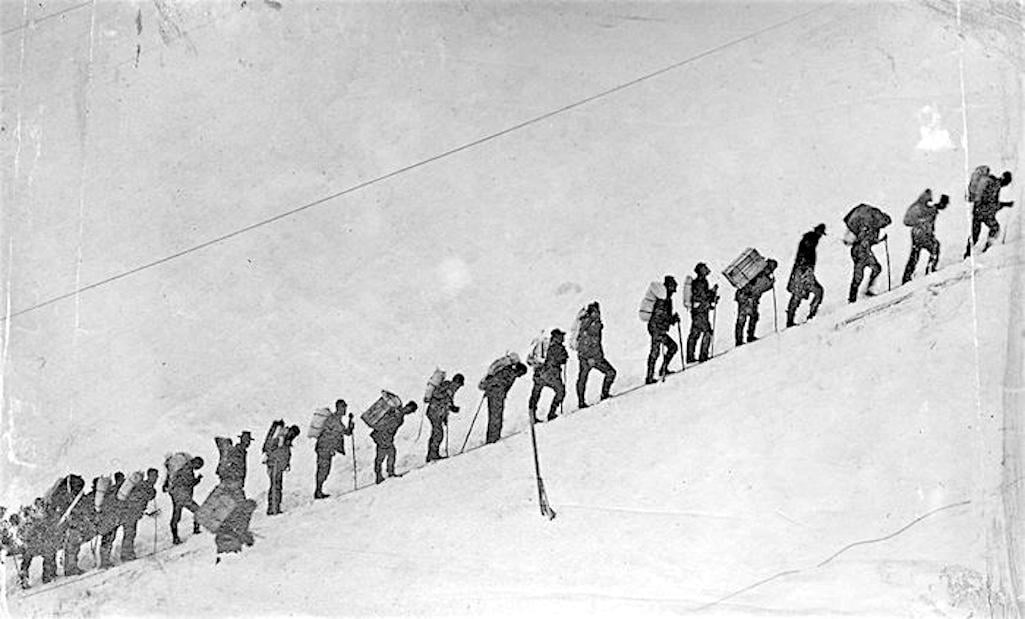
Stampeders, loaded with gear, wait in line starting up Chilkoot Pass. National Park Service, Klondike Gold Rush National Historical Park, Candy Waugaman Collection, KLGO Library SS-126-8831
Klondike Gold Rush National Historical Park has announced that the Chilkoot Trail on the U.S. side of the border with Canada will be open to mile 4 for the 2024 season. Work completed by the park last year and this coming spring will extend the amount of trail that will be open to the public this summer.
Severe flood damage sustained in September and October 2022 destroyed two major bridges along the Taiya River, and washed-out or displaced other bridges, campsites, and visitor amenities.
“With the successful completion this spring of a temporary bridge that spans the lower Taiya River at mile 1.5, we are able to open more of the Chilkoot Trail,” said park Superintendent Angela Wetz. “I’m proud of the hard work our crews have done to get more of the trail open to the public in 2024. As we learn more, we will continue to provide timely information to the community, business operators, and our partners at Parks Canada.”
With the new section of trail open as far as mile 4, visitors should have about a 7-hour roundtrip day-use experience this summer. Additional work both on the trail and with local landowners is needed before the park can allow the public to access the entire length of the Chilkoot Trail to the Canadian border.
The portion of the trail in Canada is expected to be accessible. Reservations are required to hike the Canadian side of the Chilkoot Trail, which will be open between June 1 and September 13. Call Parks Canada starting March 27 at 1-800-661-0486 to make your reservation.
In 2023, U.S. Sen. Lisa Murkowski was instrumental in designating the Chilkoot as a national historic trail. The Chilkoot is the highest profile and most popular hiking trail in Alaska. In prior years, it has attracted thousands of visitors from all over the world to hike the historic mining route into Canada. The total cost to repair the damage from disaster events in August 2021 and October 2022 is estimated to be at least $2,025,866. Updates will be posted as additional information comes available.
The historic trail, which climbs steeply through coastal and boreal forests to alpine tundra, is open to hardy hikers. Today, the Chilkoot Trail is a 33-mile recreational trail (16 miles are in the United States). Each year, more than 10,000 people day-hike, backpack, or trail run this corridor. As they do, they pass hundreds of artifacts left behind by gold seekers. In 2022 the trail was officially designated the Chilkoot National Historic Trail.
Klondike Gold Rush National Historical Park was created in 1976 to preserve and interpret the historic structures, trails, artifacts, landscapes, and stories associated with the Klondike Gold Rush of 1897-98. The park preserves 23 historic structures in Skagway, the historic Chilkoot Trail in partnership with Parks Canada, and is the most visited national park site in Alaska.
The Klondike Gold Rush, which began in 1897, brought a human flood to and through Skagway, a key access point to the gold fields in Canada's Yukon Territory.Those who struggled up the trail with hopes of striking it rich in the gold fields were required by Canadian authorities to carry 2,000 pounds of gear. The North West Mounted Police scrupulously enforced this rule at the border. Among the essential foods in this fabled "ton of gear" — enough to last a man one year — were 350-400 pounds of flour, 150 pounds of bacon, 125 pounds of of beans, 75 pounds of dried fruits, 10 pounds of coffee, and 25 pounds each of sugar, dried potatoes, and rolled oats.

 Support Essential Coverage of Essential Places
Support Essential Coverage of Essential Places






